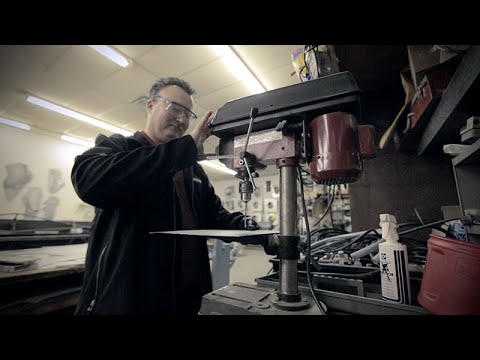Career Overview
Heating, refrigeration and air conditioning mechanics install, maintain and repair residential, commercial and industrial heating, ventilation and cooling systems.
Individuals work for installation contractors, construction companies, food wholesalers, engineering firms and retail outlets and chains, home and building renovation firms, hospitality and servicing businesses. They may also be self-employed. They may work on large projects for retail chains like grocery stores, warehouses or commercial outlets and housing developments, or they might work on smaller jobs in homes, convenience stores or restaurants.
Job Titles
Duties
Refrigeration and air conditioning mechanics:
- Read and interpret blueprints, drawings and other specifications
- Measure and lay out reference points for installation
- Use hand and power tools to assemble and install refrigeration or air conditioning components, such as motors, controls, gauges, valves, circulating pumps, condensers, humidifiers, evaporators and compressors
- Measure and cut piping, and connect piping using welding and brazing equipment
- Install, troubleshoot and overhaul entire heating, ventilation, air handling, refrigeration and air conditioning systems
- Start up system and test for leaks
- Recharge system with refrigerant, test regulators, calibrate system and perform routine maintenance or servicing
- Repair and replace parts/components for entire refrigeration, air conditioning, ventilation or heat pump systems
- May install, maintain and repair equipment in refrigerated trucks used to transport food or medical supplies
- May prepare work estimates for clients as well as write work orders, inspection sheets and other paperwork
Earnings
Earnings is income that workers receive in exchange for their labour. Depending on the type of employment, earnings can be in the form of wages (hourly), salaries (fixed monthly or annual) or self-employed earnings.
Work Environment
# Workers Employed
3,335% Employed Full Time
63%People in this job generally work 40 hours per week. Overtime and on-call work is sometimes needed to finish a project on time or to quickly repair critical equipment (for example, freezers containing food or medical items).
Refrigeration and air conditioning mechanics typically work onsite at the job, which may be in buildings under construction or in warehouses, office towers, hospitals, schools or stores. While working, they may be in a cold area like a freezer for a long period of time or work in a hot area when repairing the heating system or air conditioning. Some people in these jobs may do some work in an office, filling out paperwork. There are also times when they may need to work outside and must deal with different weather conditions.
People in these jobs may need to work in small spaces and cramped positions. Sometimes, they work from heights and lift heavy items. Some safety risks come from using heavy equipment or from electrical shock. On-the-job safety training is provided and safety procedures must be followed, particularly when handling potentially harmful refrigerants.
They should be able to work on their own, be good at solving problems and have good communication and customer service skills.
Career Pathways
Refrigeration and air conditioning mechanics may begin their careers as shop hands or in entry-level positions, or they may begin as apprentices.
With experience, refrigeration and air conditioning mechanics can advance to supervisory positions or start their own businesses.
People in this career who upgrade their skills and know how to use new technology and equipment can position themselves as specialists, which can help to advance their career.
Occupational Interests
It’s important to understand what kinds of occupations align with your interests.
For more about occupational interests visit Skills for the Future Workforce > Characteristics.
Here are the top occupational interest(s) for this career profile:
Education, Training and Skills
Completion of secondary school with English 12 and Math 11 is not mandatory but is preferred. A valid driver's licence is usually required to work in this field. Refrigeration and air conditioning mechanics must be certified to work in B.C. They also must hold a Class B Gasfitter’s licence. To become certified, workers must complete a four-year apprenticeship program. The B.C. government is introducing skilled trades certification beginning with a total of 10 trades, including refrigeration and air conditioning mechanics. Certification will be implemented in phases between 2022 and 2024. Learn more about skilled trades certification.
Apprenticeship programs
Work experience and in-class instruction are part of apprenticeship programs. Some part-time and online programs may be available. To apprentice, workers must be sponsored by an employer. A person who successfully completes an apprenticeship program and the final certification exam earns a Certificate of Qualification. Workers with significant experience in the trade may be able to challenge the certification exam to earn the Certificate of Qualification without completing a formal apprenticeship. For more information on earning a Certificate of Qualification, visit SkilledTradesBC.
To work in other provinces
Refrigeration and air conditioning mechanics may need Red Seal certification to work in other provinces. This can be earned by passing an exam and proving significant work experience.
Workers coming to B.C.
Those who are certified by a regulator elsewhere in Canada can apply for the same certification from the regulator in B.C. Under the terms of the Canadian Free Trade Agreement (CFTA), most applicants who are transferring their credentials from elsewhere in Canada will not be required to complete additional training or testing. However, the B.C. regulator may ask applicants to provide further information, such as a letter of good standing, references or a criminal record check.
Workers who trained outside of Canada
Refrigeration and air conditioning mechanics who trained outside of Canada and have never received certification from a Canadian jurisdiction will likely need a full assessment. Most occupational regulators have a process for assessment and recognize internationally trained applicants. Contact SkilledTradesBC for details on how to apply for certification in B.C.
For information about labour mobility in Canada, visit www.workersmobility.ca.
View a list of Professional Regulatory Authorities in B.C.
Education programs in B.C.

Top Skills
Every job calls for a certain set of skills. Knowing those skills is the first step in finding a good career fit.
Here, you will find the 10 most relevant workplace skills. Some are more important to achieving success in a certain career than others. These skills may come naturally to you or you may need to gain them through education, training and experience.
See the list of work-related skills below, ranked in order of importance for this career. Check out the list and see if this career matches your skills—take that first step!
Watching gauges, dials or other indicators to make sure that a machine is working properly.
Using logic and reasoning to identify the strengths and weaknesses of alternative solutions, conclusions or approaches to problems.
Determining causes of operating errors and deciding what to do about it.
Installing equipment, machines, wiring, or programs to meet specifications.
Repairing machines or systems using the needed tools.
Understanding written sentences and paragraphs in work-related documents.
Being able to solve novel, ill-defined problems in complex, real-world settings.
Conducting tests and inspections of products, services or processes to evaluate quality or performance.
Giving full attention to what other people are saying, taking time to understand the points being made, asking questions as appropriate, and not interrupting at inappropriate times.
Considering the relative costs and benefits of potential actions to choose the most appropriate one.
Labour Market Statistics
Discover data, facts and information that have been gathered and analyzed. Learn about the characteristics of the economy and labour market in B.C.
Employment
Find out about employment types and trends by region and industry.
Employment
3,335Employment by Region







| Region | Employment | % Employment of this Occupation |
|---|---|---|
| Cariboo | 115 | 3.4% |
| Kootenay | 120 | 3.6% |
| Mainland/Southwest | 2,010 | 60.3% |
| North Coast and Nechako | 25 | 0.7% |
| Northeast | 15 | 0.4% |
| Thompson-Okanagan | 545 | 16.3% |
| Vancouver Island/Coast | 510 | 15.3% |
Labour Market Outlook
The B.C. Labour Market Outlook is a 10-year forecast of the expected supply and demand for labour in the province. It’s usually updated every year. The purpose is to provide British Columbians with the knowledge to make informed decisions on careers, skills training, education and hiring.
Forecasted Job Openings (2025-2035)
1,380Forecasted Job Openings
Forecasted Employment Growth Rate
Composition of Job Openings
Job Openings by Region (2025-2035)







| Region | Job Openings | Avg. Annual Employment Growth |
|---|---|---|
| Cariboo | 40 | 1.3% |
| Kootenay | 20 | -0.7% |
| Mainland/Southwest | 840 | 2.0% |
| North Coast and Nechako | 0 | 0.8% |
| Northeast | 0 | -0.1% |
| Thompson-Okanagan | 260 | 1.4% |
| Vancouver Island/Coast | 220 | 1.5% |
Industry Highlights
Learn about the opportunities in B.C.'s major industries, including employment trends, earning potential, locations of work and more.
Forecasted Job Openings by Industry
| Industry | Job Openings (2025-2035) |
|---|---|
| Construction | 1,060 |
| Repair, Personal and Non-Profit Services | 50 |
| Wholesale Trade | 50 |
| Manufacturing | 50 |
| Retail Trade | 40 |
Insights from Industry
Many job openings will come from the need to replace those who retire.
The construction industry has traditionally created strong demand for workers in both residential and non-residential sectors. Government funding for capital projects is also an important source of work. Also, there’s been an increase in companies who need their heating, refrigeration and air conditioning systems serviced.
An increased focus on the environment and energy conservation has created a demand for energy-saving heating and air conditioning systems. With the need for better energy management and environmentally safe refrigerants, older systems in existing homes and buildings are being replaced with more efficient systems.
The increasing use of technology in refrigeration and air conditioning, such as control systems, as well as new forms of refrigerants, requires mechanics to be up to date with the latest systems and developments. Workers with current technological knowledge will have more employment opportunities.
Resources
-
American Society of Heating, Refrigerating and Air-Conditioning Engineers (ASHRAE)www.ashrae.org
-
BuildForce Canadawww.buildforce.ca/en
-
Careers in Constructionwww.careersinconstruction.ca
-
Heating, Refrigeration and Air Conditioning Institute of Canada (HRAI)hrai.ca
-
Red Seal Programwww.red-seal.ca/eng/welcome.shtml
-
Refrigeration Service Engineers Society (RSES)www.rses.org
-
Skilled Trades Employment Program (STEP)www.stepbc.ca
-
SkilledTradesBCskilledtradesbc.ca/
-
Trades Training BCwww.tradestrainingbc.ca
-
United Association (UA) Local Union 516 (Refrigeration Workers)www.ua516.org
-
Vancouver Regional Construction Association (VRCA)vrca.ca
-
WorkBC Trades Trainingnumber41media1.gathercontent.com/item/12593104








